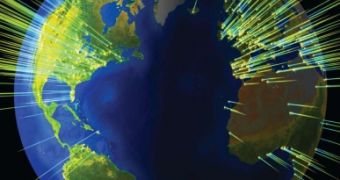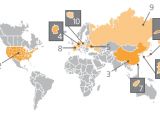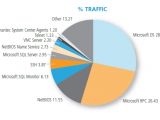Akamai Technologies has released a report regarding “the state of the Internet” for the second quarter of 2008, and it lists Japan as being the primary source of attack traffic, followed by US and China. According to the report, in the second quarter of 2008, Japan accounted for 30% of the total global attack traffic.
Akamai monitored the traffic across its global content distribution network. The network is composed of more than 30,000 servers and the data gathered covers 139 unique countries. The report includes statistics regarding aspects like attack traffic, DoS attacks, website hacks, network outages, unique IP addresses and high broadband connectivity.
Akamai not only monitored the attack traffic, but also the targeted network ports. With Japan (30%) and US (21%) accounting for over 50% of such traffic, the difference between them and the rest of the countries is quite significant. China comes in third with 8%, followed by Germany with 5.5%. The rest of the countries are under the 4% mark, which, interestingly enough, is where Japan was situated in the report for the first quarter.
Akamai cannot explain this huge spike in Japan's attack traffic from 3.6% in the first quarter to 30% in the second one. In this regard, the report notes that even though Japan ranks third in the high broadband connectivity statistics, "there does not appear to be a clear and obvious link between the high-speed connectivity and the likelihood that a country is a leading source of attack traffic."
The report also makes an interesting note regarding the exploits used based on the most attacked ports. The conclusion is that a lot of older exploits are still actively used, which means there still are a lot of systems left unpatched. “Slammer, Sapphire, and Sasser worms may still be active, particularly in Japan, the United States, and China,” the report points out. The most targeted ports were 445 Microsoft-DS (28.5%), 135 Microsoft-RPC (26.5%) and 139 NetBIOS (11.5%).
More recent threats like DNS hijacks, to which well-known service providers like Comcast, Photobucket or ICANN have fallen victim, have also been mentioned in the report. Other interesting statistics put US in first place for unique IP addresses (102,006,996), out of the total 346,151,241 unique IPs spotted on a global scale. China comes in second, but it's far behind the US with 34,004,601 unique addresses. However, when unique IP per capita is taken into account, US drops to 7th place with 0.34, while Sweden takes first place with a score of 0.42.
When it comes to high broadband connectivity levels, US is in 6th place with 26%, South Korea leading with 64%, followed by Japan with 52%. Delaware seems to be the “fastest” state in the US, with a 66% high-broadband connectivity level, followed by Rhode Island (43%) and New York (40%).

 14 DAY TRIAL //
14 DAY TRIAL // 

